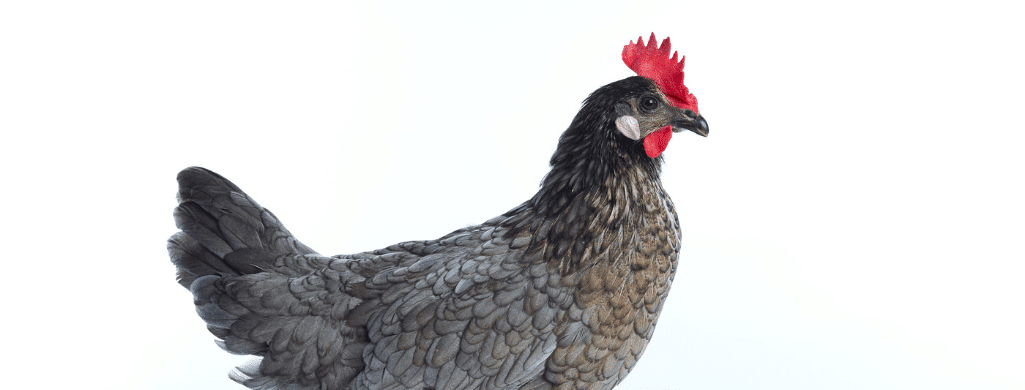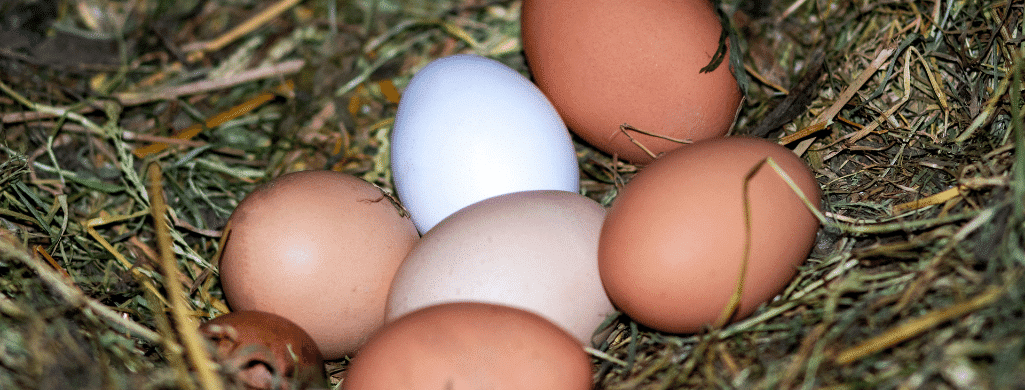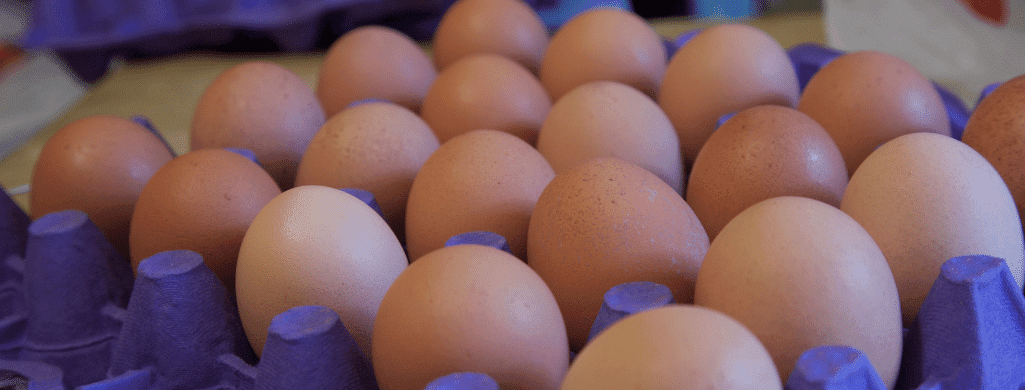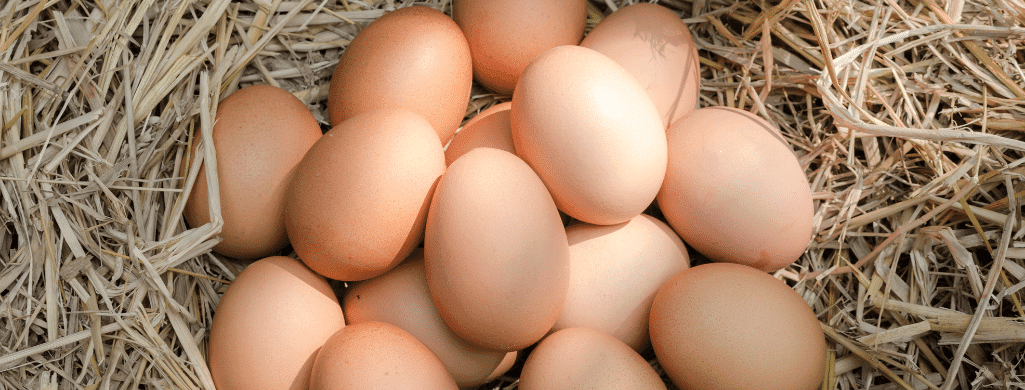Delaware chickens are a mixed breed developed in the 1940s.
These birds were popular until the 1980s when the even faster-growing Cornish Cross shadowed them.
Dedicated breeders revived this beautiful chicken breed; now, Delaware chickens are on the rise in backyard flocks.
Originally bred in a hatchery dedicated to breeding the best egg layers, Delaware chickens are prolific layers and delicious meat birds.
Read on to find out the basics about these jumbo eggs.

Table of Contents
ToggleWhat Are Delaware Chicken Eggs?
Delaware chickens lay extra large to jumbo eggs. These eggs are a medium brown color. Once they begin to lay, a Delaware chicken can lay about 4 eggs per week.
Eggs are classified on a scale with sizes labeled from peewee to jumbo.
Jumbo chicken eggs weigh at least 2.5 ounces and are the largest size.
They are not as common as large eggs.
Delaware eggs are even rarer because this breed is not as popular nowadays.
Delaware chickens are brown egg layers.
Brown eggs come from a pigment secreted in a chicken’s egg glands called protoporphyrin IX.
The coloration is deposited on all layers of the eggshell but mostly on the outermost layer.
Some studies have suggested that the depth of color is affected by the hens’ housing, feeding, health, and age.
Hens will produce the best eggs with access to oyster shells, fresh water, and choice feed.
Without speckling, these fawn-colored eggs are reportedly richer in flavor than white chicken eggs.
These eggs have strong shells.
Forage-fed chickens have more variety in their egg yolk color.
A Delaware chicken can lay up to 200 of these eggs per year.

What Age Do Delaware Chickens Start Laying?
Delaware chickens begin laying eggs at around 6 months old. Some Delawares will even lay eggs sooner than this. Their early egg-laying ability makes them prized egg producers.
These beautiful birds are mixed-breed chickens with white feathers all over except for black feathers around the neck and tail.
It was created by chance when a hatchery was breeding Rhode Island Reds for better egg-laying abilities.
Occasionally, a sport white bird would be produced.
George Ellis, a 1940’s chicken breeder, decided to take these “sport” chickens and breed them.
These beautiful chickens were selected for fast growth and great egg-laying ability.
They were originally called Indian Rivers.
They were very popular in the chicken industry for being fast, dual-purpose birds until an even faster-growing chicken entered the scene.
As such, this breed matures very quickly.
Further Reading: Delaware Chicken Maturation/Growth Guide

When Do Delaware Chickens Lay Eggs?
Delaware chickens will be their most productive from 1.5 – 2 years of age. They will continue to lay through winter. Their egg production rate will begin to decrease after 2 years of age by about 10% each year.
These excellent layers have earlier egg production than many other breeds of chicken.
As hens age, their eggs become larger, producing fewer eggs.
Most of your Delawares’ jumbo eggs will be produced during years 3 and 4 of their lives.
Delawares have a life expectancy of about 6 – 7 years, so they will begin to taper off in egg production towards the end of their lives.
Do Delaware Chickens Go Broody?
It is rare for a Delaware chicken to go broody. They produce a large amount of eggs quickly. Good egg layers are often not very broody. The egg industry breeds their best egg layers to lack this quality, so they will continue to lay more eggs instead of stopping production by sitting on a clutch.
Every once in a while, you will get a Delaware chicken who is willing to hatch her own eggs.
Yet, owners claim this is very uncommon.
Backyard chicken folks are better off getting another hen to brood them.
You may also purchase an incubator to hatch eggs for chicks.
Even if the Delaware chicken isn’t broody, she is a friendly chicken who is a good layer and makes a great pet.
Related Reading: Are Delaware Chickens Noisy?

Are Delaware Chickens Good Egg Producers?
Delaware chickens are good egg layers. They produce around 200 eggs per year. They were produced as dual-purpose chickens at the height of the Delawares’ popularity.
Delawares, also known as Indian Rivers, were once known for only laying around 100-150 eggs yearly.
Then, their breed declined in popularity in the late 1980s and early 1990s.
At this point, some breeders kept the Delaware breed alive, but some of their egg-laying capability increased.
Some listings classify these birds as egg producers with a secondary function as meat producers.
How Do You Hatch Delaware Chicken Eggs?
Another broodier hen or an incubator must hatch most Delaware hatching eggs. Since Delaware chickens don’t go broody often, they do best in mixed flocks. Then, another broodier hen may be used to hatch the eggs.
Many heritage breeds are great brooders.
Once you notice a hen go broody, simply place these eggs in her nest.
A broody hen can usually sit on up to a dozen eggs simultaneously.
Another option for hatching Delaware eggs is to use an incubator.
The best time to incubate chicken eggs is between March and May for optimal chick growth.
The following steps should be followed to incubate chicken eggs:
- Select the best-looking fertilized eggs. They should be rounder on one end and more pointed at the other.
- Set aside the eggs for 5 – 7 days at 55° degrees Fahrenheit (13° C).
- Candle the eggs to see if there are veins. This means the egg was properly fertilized.
- Place the eggs in an incubator like this one here. Make sure the humidity tray is filled and turn it on.
- Every few days, candle the eggs to see if they are developing.
- Also, make a note of the temperatures each day. Remove any eggs not progressing on days 14-19.
- On day 19, remove the eggs from the turner. Chicks should begin hatching at around day 21.
Breed a Delaware hen with a New Hampshire Red or Rhode Island Red to produce sex-linked chicks.
Sex-links are baby chickens whose sex is easily identified by its feather color on the day it hatches.
This helps buyers select hens or roosters, as desired, instead of guessing at them.
Are There Egg Quality Issues For Delaware Eggs?
Delaware eggs are usually healthy, large, brown eggs. Yet, there are some quality issues backyard chicken keepers worry about, such as small eggs and soft shell eggs.
A petite egg from a large egg-laying hen may be disturbing, but it is normal.
These eggs are usually laid by a young pullet.
These are much more common for first-time layers.
“Fairy eggs,” as they are sometimes called, don’t often have a yolk.
Young layer hens produce soft shell eggs occasionally.
These eggs made it through the oviduct without getting the final, hard outer layer.
Seeing these eggs can mean your hens need more calcium.
All laying hens should have quality laying feed, which has added calcium to aid with egg production.
There are many options, such as Purina Layena +, found here on Amazon.
Supplement your hens’ feed with oyster shells to give your chickens extra calcium during laying season.
Supplemental calcium will not only help prevent soft shell eggs, but it will also help produce stronger shells and healthier eggs overall.
Do Delaware Chickens Suffer From Any Egg-laying Related Health Issues?
Delaware chickens are usually hardy chickens with few health issues. Still, since they are good egg layers, they can sometimes suffer from egg binding and lash eggs.
Egg binding occurs when a chicken cannot lay an egg.
Older and obese chickens have a higher risk of this happening.
However, other factors, such as genetics and premature laying, can cause egg binding.
This health issue is very serious.
The egg typically gets stuck between the cloaca and the uterus.
You will see your hen standing, pumping her tail to move the egg along.
To help the chicken pass the egg, remove her from the rest of the flock.
Feel to see if it is an egg she is trying to pass.
There are a few options.
Let her soak in a tub of warm water with some Epsom salts for 20 minutes to help her relax and pass the egg naturally.
You may also use a lubricant to remove the egg, such as petroleum jelly.
Finally, extract the contents of the egg and gently remove the shell.
With all these options, it’s important to ensure the egg doesn’t break inside your Delaware hen because it could lead to infection.
Another egg-laying health issue your Delaware hen could suffer from is lash eggs.
Lash eggs aren’t eggs.
They result from an infection inside the oviduct caused by E. Coli or Mycoplasma.
These “eggs” are pus and debris.
This disease may be treated with antibiotics if caught early.
How useful was this post?
Click on a star to rate it!
We are sorry that this post was not useful for you!
Let us improve this post!
Tell us how we can improve this post?
